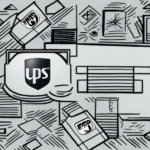Understanding UPS Standard Shipping Rates
Shipping rates can be a daunting topic for many businesses, but it is a necessary consideration for those involved in transporting goods. This article explores the ins and outs of UPS Standard Shipping rates, including what it is, how it works, and the factors that determine cost. We also provide useful tips on how to save money, negotiate better rates, and track your shipments for smooth delivery. Let us begin exploring UPS Standard Shipping Rates.
What is UPS Standard Shipping?
UPS Standard Shipping is one of the most popular shipping methods offered by United Parcel Service (UPS), covering ground transportation within the United States and Canada. It is a cost-effective and reliable option for businesses that do not require expedited shipping services.
With UPS Standard Shipping, packages are typically delivered within 1-5 business days, depending on the distance and destination. This shipping method includes tracking and delivery confirmation, allowing businesses to monitor their shipments and ensure they arrive at their intended destinations. Additionally, UPS offers a variety of packaging options and shipping supplies to streamline the shipping process for businesses.
The Importance of Understanding Shipping Rates
One of the most significant expenses for businesses involved in shipping goods is the shipping rates. Understanding these rates is essential for determining pricing for your customers and optimizing cost-effectiveness for your business. By comprehending the factors that determine your shipping rates, you can better plan and budget your shipping expenses.
The primary factors influencing shipping rates include the weight and size of the package. Heavier and larger packages typically cost more to ship than smaller and lighter ones. Additionally, the distance the package needs to travel and the shipping method chosen also impact the shipping rates.
The carrier you choose is another crucial consideration. Different carriers may offer varying rates and services, so it is essential to research and compare options to find the best fit for your business needs. Some carriers may also offer discounts for bulk shipping or frequent shipments, which can help reduce overall shipping costs.
How Do UPS Standard Shipping Rates Work?
UPS Shipping rates are calculated based on several factors, including the weight of the package, the destination, the service level chosen, and any additional services requested. UPS offers a variety of packaging options, including envelopes, boxes, and tubes, each with their respective weight and dimensional limits.
UPS Standard Shipping rates are typically based on a combination of the package weight and the distance traveled, using a formula that charges more for longer distances and heavier packages.
It's important to note that UPS also offers discounts for high-volume shippers and negotiated rates for businesses with regular shipping needs. Additionally, UPS provides various shipping options, including ground, air, and international services, each with their own rates and delivery times. Customers can track their packages in real-time using UPS's online tracking system, which provides updates on the package's location and estimated delivery time.
Factors That Determine UPS Standard Shipping Rates
Several factors determine the UPS Standard Shipping Rate. Here are some of the most significant:
- Package dimensions and weight
- Destination and distance
- The USPS ZIP code nearest to the origin of the package
- The UPS service level selected (e.g., UPS Ground, UPS 2nd Day Air)
- Additional services requested (e.g., signature confirmation, insurance)
The type of item being shipped can also affect UPS Standard Shipping Rates. Items such as hazardous materials or oversized items may require special handling and incur additional fees.
Seasonal factors can impact shipping rates as well. During peak holiday seasons, shipping rates may increase due to high demand and limited availability.
How to Calculate UPS Standard Shipping Rates
Estimating UPS Standard Shipping rates is easy with their online tool. The tool provides a quick, accurate, and reliable estimation of shipping costs. Simply enter the origin and destination of your shipment, package dimensions and weight, and select the desired service level. The tool will calculate the cost of shipping the package and present you with multiple service level options.
UPS Standard Shipping rates may vary depending on the type of package being shipped. For example, rates for a small envelope may differ from rates for a large box. Additionally, UPS offers discounts for high-volume shippers, so frequent shippers may benefit from exploring their discount programs.
The distance between the origin and destination also affects UPS Standard Shipping rates. Shipping a package across the country will likely cost more than shipping within the same state. To save on shipping costs, consider using UPS's Ground service for domestic shipments, which is typically less expensive than their air services.
Common Mistakes to Avoid When Estimating Shipping Costs
Mistakes in estimating shipping costs can lead to budget overruns and lost revenue. Here are some common mistakes to avoid:
- Underestimating package weight or dimensions
- Not considering additional service fees, such as insurance or signature confirmation
- Ignoring fluctuating fuel prices that can affect shipping costs
- Not regularly reviewing shipping rates, resulting in inflated costs over time
Another common mistake is not accounting for the destination of the package. Shipping to remote or international locations can result in higher costs due to customs fees, taxes, and other charges.
It's also important to consider the shipping method being used. Expedited or overnight shipping options may be more expensive than standard shipping and should be factored into the overall cost estimate.
Tips for Negotiating Better UPS Standard Shipping Rates
Businesses can save money on UPS Standard Shipping rates by negotiating better rates with UPS. Here are some tips for negotiation:
- Compare UPS rates to other shipping carriers' rates and use the lowest quote as leverage for negotiations
- Provide volume estimates to UPS to make the case for reduced rates
- Negotiate long-term contracts for more significant savings
- Utilize UPS’s Loyalty program options for additional savings
Consider the timing of your negotiations. Negotiating during the off-season or slower months may result in more favorable rates. Additionally, having a clear understanding of your shipping needs and requirements before entering negotiations will allow you to effectively communicate your needs and negotiate a rate that works for your business.
Maintaining a positive and professional relationship with your UPS representative is also crucial. Building a strong relationship can lead to better rates and more favorable terms in the long run. Regularly reviewing your shipping needs and rates can help ensure that you are getting the best possible deal from UPS.
How to Save Money on UPS Standard Shipping Rates
In addition to negotiating better rates, businesses can save money by taking advantage of other cost-saving strategies:
- Reduce package weight and dimensions to fit within lower rate tiers
- Choose a slower delivery speed for less expensive shipping
- Use free packaging options offered by UPS, such as envelopes or flat rate boxes
- Take advantage of economies of scale by grouping multiple shipments together to save on per-package shipping costs
Another way to save money is by using UPS My Choice, a free service that allows you to customize your delivery preferences. By choosing to have your packages delivered on a specific day or time, you can avoid missed delivery attempts and additional fees.
Businesses can also save money by utilizing UPS's online shipping tools, such as UPS WorldShip or UPS CampusShip. These tools allow you to easily create shipping labels, track packages, and manage your shipping history. By streamlining your shipping process, you can save time and money on shipping costs.
Alternatives to UPS Standard Shipping for Cost Savings
For businesses looking for cost-saving alternatives to UPS Standard Shipping, other shipping carriers offer comparable services at competitive rates. Some of these alternatives include:
- FedEx Ground
- USPS Priority Mail
- DHL eCommerce
- Amazon Shipping
While these alternatives may offer cost savings, they may not always be the best option for every business. Factors such as shipping volume, delivery timeframes, and package size and weight should be considered when choosing a shipping carrier. Additionally, businesses should research each carrier's reputation for reliability and customer service before making a decision.
Understanding the Different Service Levels Offered by UPS
UPS offers a range of service levels to fit different business needs, appealing to various customer bases with differing delivery speeds, costs, and added services. Businesses should review available service levels to find the most cost-effective solution for their shipping needs. Here are some of the service levels offered by UPS:
- UPS Ground
- UPS 2nd Day Air
- UPS 3 Day Select
- UPS Worldwide Express
- UPS Next Day Air Saver
UPS Ground is the most economical shipping option offered by UPS. It is ideal for businesses that have less time-sensitive shipments and want to save on shipping costs. This service level offers delivery within 1-5 business days, depending on the distance between the origin and destination.
UPS Worldwide Express is a premium service level offered by UPS for international shipments. It offers guaranteed delivery within 1-3 business days to over 220 countries and territories worldwide. This service level includes customs clearance and door-to-door delivery, making it an ideal option for businesses that need to ship urgent and time-sensitive international packages.
How to Choose the Right Service Level for Your Business Needs
Choosing the right service level for your business needs requires a thorough understanding of delivery requirements and financial limitations. Here are some factors to consider when choosing your service level:
- Delivery speed requirements
- Geographic location of the package's destination
- Package size and weight
Tracking Your UPS Shipments: What You Need to Know
UPS provides several ways to track shipments to ensure they reach their destination on time. Customers can track their packages online or on-the-go using the UPS app.
UPS also offers proof of delivery and signature confirmation services, which are particularly useful for businesses that require confirmation of delivery for higher value goods or legal purposes.
How to Handle Issues with UPS Shipments and Delivery
Issues can arise with UPS shipments, such as lost packages, late deliveries, or damaged goods. It's essential to have a plan in place to handle these issues quickly and effectively. Businesses should contact UPS customer service for assistance and file claims promptly.
Conclusion: Mastering the World of UPS Standard Shipping Rates
Navigating the world of UPS Standard Shipping rates can be challenging, but with knowledge and effort, businesses can master the process. Understanding UPS Standard Shipping, negotiating better rates, and choosing the right service level can save time and money. By implementing the tips provided in this article, you will be better equipped to navigate UPS Standard Shipping rates and optimize your business’s shipping expenses.




















